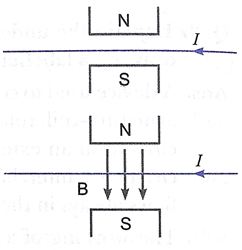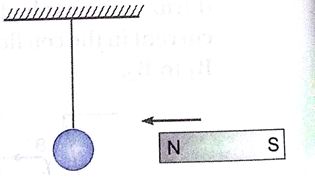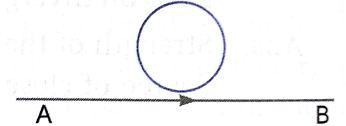Magnetic Effects of Electric Current
Que 1. Meena draws magnetic field lines of field close to the axis of a current – carrying circular loop. As she moves away from the centre of the circular loop she observes that the lines keep on diverging. How will you explain her observation?
Ans. Strength of the magnetic field falls as distance increases. This is indicated by the decrease in degree of closeness of the lines of field.
Que 2. Why does a magnetic compass need le pointing North and south in the absence of a nearby magnet get deflected when a bar magnet or a current carrying loop is brought near it?
Ans. Current – carrying loops behave like bar magnets and both have their associated field lines. This modifies the already existing earth’s magnetic field and a deflection results.
Que 3. A wire is placed between N and S poles of a magnet as shown in figure. If current flows in the wire as shown, in which direction does the wire tend to move?

Ans. The direction of magnetic field is from N-pole to S-pole; on applying Fleming's left-hand rule, the wire tends to move perpendicular to plane of paper upward.
Que 4. A fixed wire AB carries current I. An electron is moving parallel to the wire, in which direction does the electron tend to move?

Ans. By right-hand thumb rule, the magnetic field in the vicinity of wire is downward perpendicular to plane of paper. The conventional direction of electric current is opposite to the direction of motion of electron. By Fleming's left-hand rule, the force on electron is away from wire in the plane of paper; therefore, the electron will be deflected downward (away from wire) in the plane of paper.
Que 5. A metallic wire loop is suspended freely and a bar magnet is brought near it as shown in the diagram.
What will be the direction of induced current in the wire loop when the magnet is moved towards it.

Ans. Anticlockwise from the side of a magnet.
Que 6. Two wires each carrying a steady current i are shown in two different configurations in column I. The magnetic field produced due to current in the wires is described in column II. Match the situations A and B in column I with all the correct statements in column II.
|
Column I |
Column II |
|
A. Point P is situated midway between the wires above. B. Point P is situated at the mid point of the line joining the centres of the circular wires, which have same radii.
|
(i) The magnetic fields B at P due to the current in the wires are in the same direction. (ii) The magnetic fields B at P due to the current in the wires are in the opposite directions. (iii) Magnetic field at P is zero. |
Ans. (i) A matches with (ii) and (iii), Applying Fleming's Left Hand Rule, the magnetic field at P due to the current will be equal and in opposite direction.
(ii) B match with only (i) in column II. Applying Fleming's Left Hand Rule, the magnetic field at P due to two currents in opposite directions will be in directions.
Que 7. A circular metallic loop is kept above the wire AB as shown here. What is the direction of induced current produced in the loop, if any, when the current flowing in the straight wire
(i) is steady, i.e., does not vary.
(ii) is increasing in magnitude.
Justify your answer in each case.

Ans. (i) No induced current will be produced in the loop since the constant current flowing in the straight wire produces a constant magnetic field. Hence no induced current is produced in the loop.
(ii) Since current in the straight wire is changing, the magnetic flux associated with the loop will change and hence induced current will be produced in it.
Applying Fleming's Right Hand Rule, the current flowing in the loop will be in clockwise direction.
Que 8. An electron and a proton, using parallel to each other, enter a uniform magnetic field with same velocity. The direction of magnetic field and their motion coincides (is same). How will the direction of their paths be affected when they are travelling in
(a) same direction (b) opposite direction.
Justify your answer.
Ans. A magnetic field does not exert any force on a charge moving parallel or antiparallel to the field direction. Since they are travelling in the direction of the magnetic field, there will be no force acting on them. Hence their paths will remain the same after entering the magnetic field.
Que 9. You are given a galvanometer, an electroplating equipment, a key and two sources of electricity. Give two different experimental set ups to find whether any of the given sources is AC or DC source.
Ans. (a) We can connect the galvanometer to any one of the sources using a key in the circuit. If the galvanometer shows definite deflection in a given direction, the source taken is d.c. source. If the given source is a.c. source, the average deflection shown by the galvanometer will be zero.
(b) We can also connect the electroplating equipment to any one of the source using a key in the circuit. If electroplating takes place, the source used is d.c. source. In case of AC source, since the direction of current changes in direction periodically and alternatively, there is no definite shifting of the ions of the electrolyte and hence no electroplating takes place.
Que 10. A circuit has a fuse of 5 A. What is the maximum number of 100 watt (220 V) bulbs which can be safely used in the circuit?
Ans. Suppose X number of such bulbs can be used.
Power of one bulb = 100 watt
Power of x bulbs (P) = 100x watts
Potential difference (V) = 220 volts
I = 5 ampere
We know P = VI

Que 11. It is established that an electric current through a metallic conductor produces a magnetic field around it. Is there a similar magnetic field produced around a thin beam of moving (i) alpha particles, (ii) neutrons? Justify your answer.
Ans. (i) Yes, Alpha particles being positively charged constitute a current in the direction of motion.
(ii) No. The neutrons being electrically neutral constitute no current.



